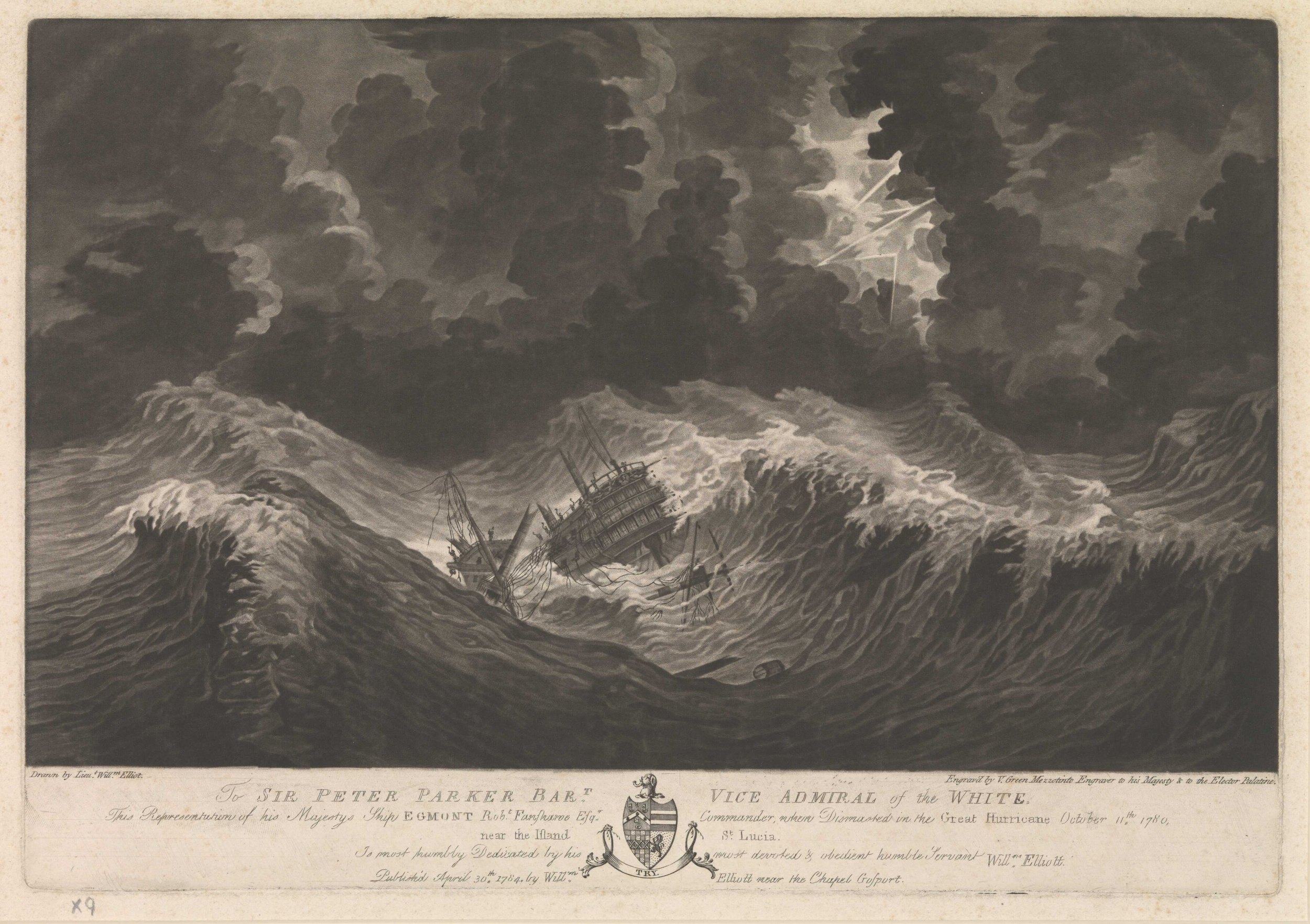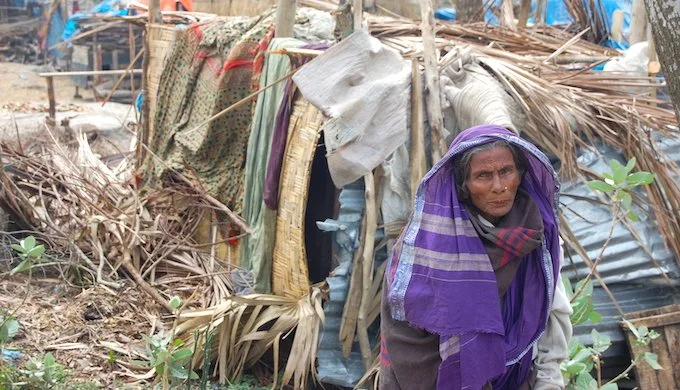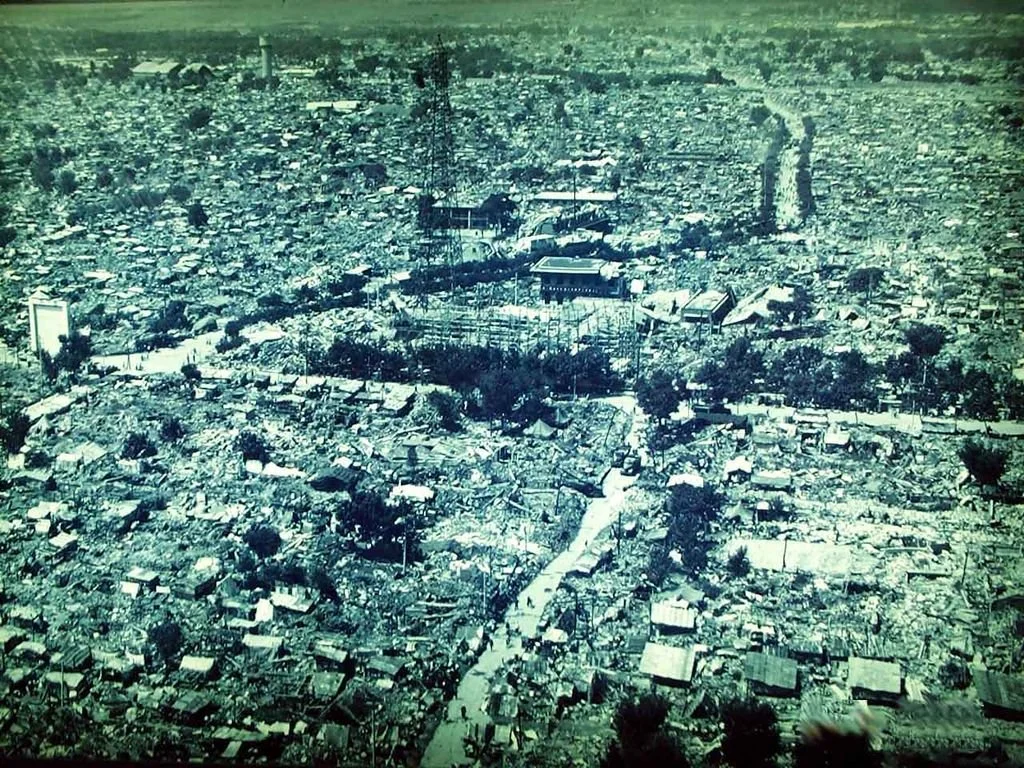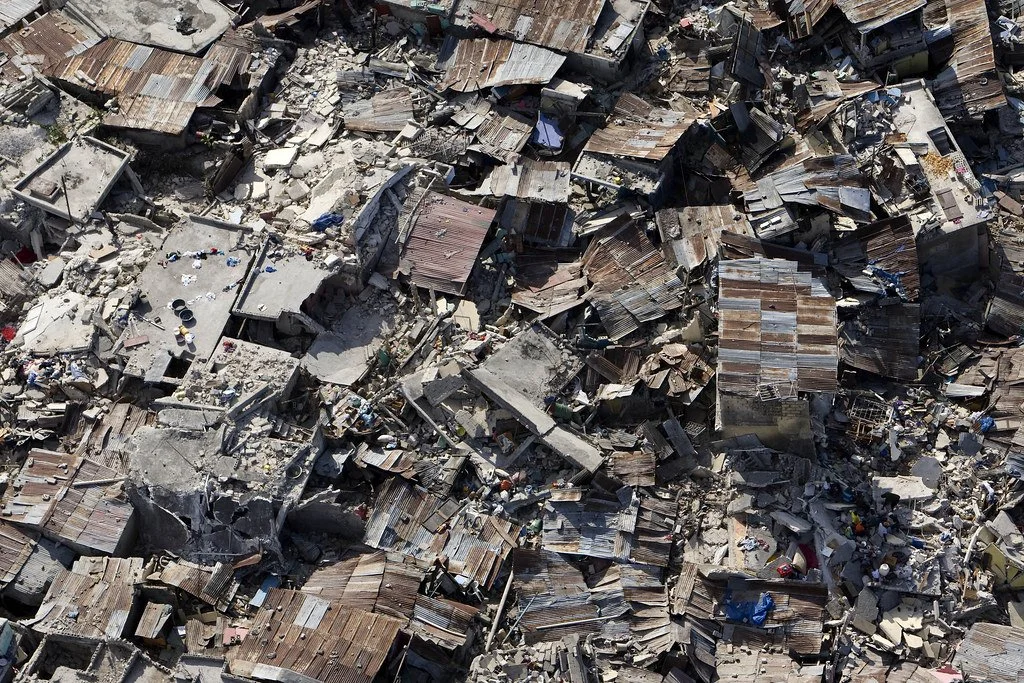Witness the awe-inspiring forces of nature unleashed through devastating hurricanes, volcanic eruptions and catastrophic floods.
The recent havoc wreaked by a wildfire in Hawaii has turned the once-idyllic summer paradise into a scene of devastation. The ferocity of another’s sweep through British Columbia and the Northwest Territories stands as a stark testament to the awe-inspiring might of Mother Nature. In contemporary times, we find ourselves confronting an array of astonishing extreme weather events and disasters. From heart-rending floods in California to merciless storms battering Mississippi, and the earth-shattering earthquakes that shook Afghanistan, these events underscore the delicate balance between human society and the natural world.
Throughout the annals of history, spanning various epochs of human progress, we encounter a recurring theme of dramatic weather and geological upheavals. Presented below are six far-reaching instances of natural disasters, each demanding a profound respect for the forces of nature.
1. The Great Hurricane of 1780
Caribbean Islands
Egmont Robt Fanshawe Esqr, Commander, when dismasted in the Great Hurricane on October 11th 1780 near the Island St Lucia. Royal Museums Greenwich. CC0.
Among the most catastrophic events etched in the annals of the Atlantic Ocean is the Great Hurricane of 1780, a tempest that swept across the Caribbean archipelago and left in its wake a death toll that neared 22,000 victims. The island of Barbados, nestled among the Lesser Antilles and situated to the north of Venezuela, bore the full brunt of this storm’s wrath. Accounts from the local inhabitants paint a grim picture: “Many ships were wrecked and many people were killed…the wall has been completely washed away by the sea and the back of the house has been left only on single struts”. With wind speeds exceeding 200 mph — a velocity that engulfs the length of a football field (300 feet) in just over a second — this storm annihilated every vestige of human civilization in its path. Trees, houses, stones, and wood crumbled before its might. Fortresses, cannons, and ships were tossed haphazardly, like mere playthings, as the tempest raged on. Its course then shifted northwestward, targeting the islands of Saint Lucia, Martinique, Dominica and Guadeloupe.
On Martinique, a nucleus of French sugar production that depended heavily on enslaved labor, the hurricane’s fury claimed a toll of roughly 9,000 lives. But the storm’s impact transcended the natural realm. It unleashed winds that bore the force of history, catalyzing a chain of events that reverberated into the American Revolution. Both British and French troops, staggered by the disaster, bore the brunt of its blow. The catastrophe was particularly unkind to the French forces, then taking part in the American War of Independence as an ally of the newly declared United States — over 40 ships were swallowed by the depths near Martinique, and the death toll among soldiers grew to around 4,000. The impact extended to the British side as well, leaving their once-potent fleet decimated by a trio of consecutive storms. In part as a result, the English presence in the northwestern Atlantic suffered a profound and enduring contraction.
2. Mount Tambora’s Eruption, 1815
Indonesia
Rocks and ashes on the ground with smoke in the background in front of a mountainrange.
Tucked away on the obscure Indonesian island of Sumbawa, the name Mount Tambora might elude recognition today. Yet, its eruption in the spring of 1815 held within it the power to reshape global weather patterns indefinitely. On a seemingly ordinary afternoon, as the sun prepared to dip below the horizon on April 10, 1815, Mount Tambora rumbled to life. An astounding 12 cubic miles of gases surged into the atmosphere, accompanied by a tumultuous eruption of dust and rocks that choked the skies and enveloped both the island of Sumbawa and its surroundings in a shroud of darkness. Amid this scene of apocalypse, inhabitants either met their end in the fiery conflagration or succumbed to the merciless hail of rocks. The handful of survivors found their once-fertile land tainted by volcanic ash and other substances, rendering it incapable of yielding crops. The ensuing famine claimed many remaining lives as starvation took its cruel toll.
The eruption, though spanning merely three days, reached its dramatic pinnacle with the mountain expelling an astounding 300 to 500 million kilograms of material every second. This eruption stands as an unparalleled event in documented history, claiming the lives of 100,000 islanders. It also unleashed the largest recorded volume of toxic sulfurous gases and volcanic ash from a single natural source. The once stately Mount Tambora, which had stood tall, now bore the scars of devastation, losing more than a third of its height as a shattering explosion rent the mountain asunder on that fateful April evening.
The 1815 Mount Tambora eruption. The red areas are maps of the thickness of volcanic ashfall.Wikipedia Commons. CC0.
The aftermath of this eruption reverberated not just in the years that followed, but has cast its shadow even upon the present day, nearly two centuries later. Geographically, the immense explosion carved out colossal craters along Tambora’s rim, plunging to depths of around 1.2 kilometers. It caused a veil of sulfate dust to enshroud the planet, casting a cooling pall over temperatures and unsettling crucial weather systems for over three years. This era, often referred to as the “Year Without a Summer,” cast its shadow in 1816. Across Europe, temperatures plummeted and precipitation surged, ushering food scarcity and triggering widespread upheavals, with protests and riots sweeping across the continent. This tumultuous atmosphere gave birth to iconic gothic literature like Mary Shelley’s “Frankenstein,” John William Polidori's “The Vampyre,” and Lord Byron’s “Darkness”. Meanwhile, North America experienced its share of hardship as well, with New England grappling with snowfall and “killing frost,” a factor that catalyzed the Panic of 1819, the United States’ first major economic depression. Moreover, the impact of this eruption radiated across the ecology of the Indian subcontinent and the Arctic, spawning pandemics and wreaking havoc on ocean currents.
3. Yangtze River floods, 1931
China
A sign for environmental protection at Yangdi village. shankar s. CC BY 2.0.
The city of Wuhan, China has gained global recognition as the ground zero of the Covid-19 outbreak. However, Wuhan's story stretches back beyond this contemporary chapter, encompassing a legacy of natural upheavals spanning nearly a century. China‘s iconic Yangtze River, an aquatic lifeline celebrated for its contributions to sustenance, irrigation, sanitation, trade and industry, harbors another facet — the potential to ravage the land with its powerful floods. The pages of history bear witness to the tumultuous year of 1931, when torrential waters surged and engulfed swaths of central and eastern China. This watery onslaught did not bustling towns of Wuhan and Nanjing, as the Republic China was torn asunder by political tumult, economic strife and relentless conflict. Amid the backdrop of droughts and challenging winters that plagued the 1920s and 1930s, the Yangtze River basin bore witness to a torrent of water cascading downstream in the spring of 1931, as ice and snow yielded to the warming sun.
Within the cradle of civilization that is the Yangtze River Basin, a substantial segment — roughly one-third — of China’s population makes their home. The specter of flooding casts its shadow, further accentuated by deforestation and the unchecked utilization of wetlands. As spring unfolded its petals, waters of the river cascaded into the thoroughfares and mingled with the discharges from Wuhan’s overburdened sewers. By the start of August in 1931, a sprawling area encompassing 180,000 square kilometers — a vast terrain akin to the collective expanse of New York, New Jersey, and Connecticut — was claimed by the deluge. Cities and hamlets submerged were in their entirety, while others stood as half-drowned relics. In the throes of the flood‘s onset, around 150,000 lives soon succumbed to its watery embrace, while the final toll remains a haunting enigma. Economic devastation ensued, obliterating years of hard-earned income for countless individuals. Amidst the aftermath, the specters of famine and disease loomed large, exacting a toll far surpassing the deluge’s immediate impact.
4. Valdivia Earthquake, 1960
Chile
This masonry office building in the downtown area of Concepcion, Chile collapsed as a result of the M 8.8 earthquake on Feb. 27, 2010. U.S. Geological Survey. CC0 1.0.
Chile’s geographical positioning atop a convergent plate boundary leaves it perpetually exposed to Earth’s shifting tectonic plates. One seismic spectacle that resounds through history is the Tsunami of May 22, 1960 — a seismic symphony that crescendoed to a magnitude of 9.5 on the Richter scale. To grasp the significance of this figure, consider that an earthquake registering between 6.1 and 6.9, like the temblor that rattled Little Antelope Valley, California near the Nevada border on July 8, 2021, can already inflict substantial devastation within densely inhabited areas. Now, imagine the seismic intensity of a magnitude 9.5 earthquake, which is an overwhelming 177,827.941 times more potent in terms of energy released than a magnitude 6 quake. This degree of seismic activity can wreak havoc, decimating any settlements in proximity to its epicenter. This seismic reckoning occurred around 3 p.m. on May 21, 1960, approximately 100 miles (160 km) offshore from Chile's coastline, tracing a parallel path to the city of Valdivia. In a time when Chile was gearing up to honor the Battle of Iquique, the coastal haven of Concepcion was suddenly plunged into turmoil. The portents of impending catastrophe manifested in violent tremors, the precursor to the cataclysmic quake that bore a magnitude of 7.9 at its inception.
The grimmest chapter unfolded the ensuing afternoon, as a seismic rupture of staggering scale snaked along a sprawling 600-mile fault line. In a dramatic geological ballet, the Nazca Plate — an expanse of the Pacific seafloor rivaling California in magnitude — descended fifty feet beneath the South American continent. The thriving harbor town of Valdivia met its demise, while a multitude of coastal settlements vanished into oblivion. This seismic drama had unforeseen consequences, expanding Chile’s realm by an area equivalent to around 1,500 football fields. Heightening the seismic spectacle, the epicenter of this cataclysm sprawled along a nearly 700 mile tract along the southern edge of the Chilean coast. The upheaval stirred up tempestuous seas, resulting in ruin across distant shores — from Hawaii and Japan to the Pacific coastline of the United States. An estimated count of two million people found themselves displaced by this seismic upheaval. In terms of monetary toll, the damage in Chile alone amounted to a staggering $550 million, with the aftermath registering a grim tally of several dozen to hundreds of fatalities and casualties from the South American and US West Coast, to Japan and the Philippines at the other end of the Pacific.
5. Bhola Cyclone, 1970
Bangladesh
A woman walks past makeshift shelters in the Cyclone aftermath, Bangladesh, 2007. Direct Relief. CC BY-NC-ND 2.0.
Bangladesh, a densely-populated delta nation born from eroded Himalayan sediments, endured the catastrophic Bhola Cyclone in 1970, impacting the country (which was then known asEast Pakistan, and part of the Pakistani state that exists today) and India’s West Bengal. The region's history of cyclones left it vulnerable, averaging nearly two annually from 1959 to 1969. Termed the “Bhola Cyclone,” it ranks among the 20th century’s deadliest disasters, claiming 300,000 to 500,000 lives. The storm's origins trace back to a dissipating tropical system over the Malayan Peninsula on November 5. Rapidly intensifying by November 12, it struck with 130 mph winds. But, as traditional danger notifications over Radio Pakistan came to an abrupt halt, coastal residents were left unaware of the impending peril's magnitude, as reported by Pakistan Press International (PPI). In the aftermath of the devastating cyclone, countless survivors were stripped of their belongings, left only with their lives, as entire villages, rice harvests and essential provisions were wiped out. Following this, outbreaks of cholera and typhoid added to the challenges.
The aftermath of the Bhola Cyclone also played a crucial role in East Pakistan's pursuit of independence from the grip of West Pakistani authority. The mishandled response to the disaster allowed the Bengali Awami League to champion both independence and political reform. This movement gathered momentum in December 1970, when the League secured victory in the elections. As a result, East Pakistan transformed into Bangladesh in 1971 — a victory for freedom caused in part by the cyclone’s impact, although independent Bangladesh would undergo periods of tyranny.
6. Tangshan Earthquake, 1976
China
July 28, 1976, Tangshan earthquake, epicenter area. Wikipedia Commons. CC0.
Tangshan, located in Hebei Province, China, felt the earth’s fury in a cataclysmic event that still resonates as one of the deadliest and most destructive earthquakes in recent memory. On the quiet morning of July 28, 1976, as darkness lingered before dawn, the thriving Chinese industrial city of Tangshan was abruptly thrust into chaos. Hints of the impending disaster were strewn outside the village of Baiguantuan. A thousand chickens, typically eager for sustenance, abandoned their feed to sound off an agitated cacophony. Mice and yellow weasels, creatures of the night, scrambled in frantic retreat, sensing the impending upheaval.
Subsequently, a seismic shock with a magnitude ranging from 7.8 to 8.2 on the Richter scale rocked the region for 23 seconds, reducing 90% of Tangshan's buildings to rubble. This was followed by a series of potent aftershocks, two of which surpassed a magnitude of 6.0. Roughly 15 hours later, a robust aftershock measuring 6.1 struck. The earthquake obliterated coal mines and the industries reliant on them, triggering the collapse of power, water, sewage, telephone, telegraph, and radio networks. The destruction of railway and highway bridges isolated the city entirely. Tragically, half of the city’s population — about a million individuals — lost their lives.
7. Ethiopia Famine, 1983 –1985
Ethiopia
Those who weathered the 1984 famine in Kobo and belong to the elder generation conveyed to ambassadors Haslach and O'Hara that the compounding impact of several unfavorable rainy seasons has resulted in the most formidable drought they have ever experienced. USAID Ethiopia. CC BY-NC-SA 2.0
In spite of a global food supply that typically suffices for the world's growing population, hunger remains an unfortunate reality in many developing nations. Over the past decade, grain yields per hectare in Africa have plunged by a third, and since 1981, food production has diminished by 15%. The year 1984 marked Ethiopia's encounter with a massive famine that reverberated across the globe, claiming around 2 million lives. A harsh drought intertwined with fierce conflicts to intensify the distress, as Eritreans fought for their autonomy and Tigrayans for their rights. This turmoil unfolded in central Eritrea and the Tigray region in northern Ethiopia, marred by arbitrary incarcerations, expulsions and ethnic cleansing. Manipulating hunger relief, the Ethiopian government used the crisis to relocate and expel Tigrayans, triggering a more volatile conflict that obstructed aid delivery to civilians in controlled areas. Consequently, sick and famished individuals congregated along stretches of Wollo's north-south road, halting vehicles in a desperate plea for sustenance — an unsettlingly frequent sight.
Accounts of hunger in Wollo and Tigray were disregarded by authorities and shrouded in secrecy. Aid organizations overlooked warning signals, prioritizing a rapport with the government. Economically, the majority of Ethiopian farmers are involved in livestock rearing or agricultural activities. Their reliance on the market to meet even their basic consumption needs is profound throughout the year. The drought of 1984 exposed the frailty of Ethiopia's political and economic systems, causing the loss of nearly 8 million lives to famine. Today, the threat of starvation still hangs over Ethiopia, impacting no less than 350,000 individuals in the Tigray region, still wracked by conflict four decades later.
8. Kashmir Earthquake, 2005
Pakistan
The meeting point of the Indian and Eurasian tectonic plates lies right in the heart of Kashmir, giving birth to the grandeur of the Himalayan mountain range through intense geological forces. This collision not only shaped the Himalayas but also unleashed tumultuous seismic activities in the area. In the early dawn of October 8, 2005, a formidable earthquake rocked northern Pakistan, leaving behind a trail of devastation. The consequences were felt deeply: villages were leveled, roads buried under rubble, and vital services such as water and electricity were severed. A staggering three million individuals found themselves homeless, while the grim count of human lives lost reached a tragic toll of at least 80,000. This seismic occurrence stands as the nation’s deadliest earthquake ever experienced. Among the most severely affected regions was Uri, where the heart-wrenching aftermath left 80% of the town in ruins.
The scene in the Muzaffarabad region of Kashmir was equally haunting, as villages laid in ruins, bearing silent witness to the aftermath of a natural disaster. Over 780,000 structures were left devastated or irreparably damaged, while countless more faced extended periods of unusability. Notably, around 17,000 educational institutions and crucial hospitals situated near the epicenter of the earthquake either crumbled or suffered significant destruction. Reporters on the ground captured heart-wrenching moments, where traumatized parents, their eyes filled with panic, gathered in search of their children. Amid the chaos, faint cries of surviving children could be discerned from the debris, a fragile ray of hope in the overwhelming despair. However, with the passage of time, those cries grew fainter, and as night descended, grieving parents began the grim task of recovering the lifeless bodies of their young ones.
9. Haiti Earthquake, 2010
Haiti
A poor neighborhood in Haiti shows the damage after an earthquake. United Nations Development Programme. CC BY-NC-ND 2.0
The 12th of January, 2010, marks a somber date in Haiti's history, forever associated with a colossal earthquake. The earth shook with a magnitude 7.0, and its epicenter in Port-au-Prince, the capital, was delivered the harshest blow. Once-vibrant neighborhoods and towering structures crumbled, nature’s unyielding might reshaping the cityscape. Haiti's geological position along a fault line between substantial tectonic plates makes it prone to seismic activity, evidenced by historical quakes in 1751, 1770, 1842 and 1946. However, the country's houses, often made of concrete and cinder block to withstand storms prevalent in the Caribbean, displayed vulnerability during earthquakes.
In a nation already locked in poverty’s grip, this catastrophe left an indelible mark. It went down in history as the most catastrophic event ever faced by the Western Hemisphere’s most destitute country. The impact was overwhelming: approximately 3 million people were caught in its fury, with an unimaginable loss of about 250,000 lives and another 300,000 grappling with injuries. A staggering 19 million cubic meters of debris, enough to stretch a mournful line from London to Beirut if gathered, signifying the immense destruction in Port-au-Prince. Amid the ruins, the education sector lay in ruins, with four thousand schools reduced to rubble or severely compromised.
10. Siberian Taiga Fires, 2019 –2020
Russia
An emergency firefighter from the Ministry dousing a forest fire near the Novovoronezh Nuclear Power Plant. RIA Novosti archive, image 733844 Alexey Kudenko. CC-BY-SA 3.0
Picturing Russia’s icy dominion of Siberia, it might appear inconceivable that this frigid realm could ever harbor one of the planet's mightiest wildfires. Yet, in early spring in 2003, this implausible chapter began to unfold, with echoes in 2019 and and again in 2020. The wildfires, sparked by lightning, stand as vital ecological players in the birthing and nurturing of boreal forests. But Siberia’s story in recent decades has taken a dangerous turn. A mix of parched conditions and heightened human involvement has triggered a surge in fires, making them more frequent and covering wider ground. This shift has altered the historical fire patterns. Between 1995 and 2005, the fires in this region shot up tenfold. And then there is 2021, when a single fire claims 40 million acres of forest. Yet, close to half of that destruction occurred in 2019 and 2020. This hints at a potential threshold, potentially already passed, after which extreme fires could become a common occurrence in the region.
With more than a fifth of the world’s forested expanse within its borders, these lands are home to many Indigenous and local communities in underdeveloped areas that rely on the boreal forest for timber. Real peril surfaces for these groups when they face Siberia’s peculiar wildfires, aptly named “Zombie” fires. These are wildfires that possess the eerie ability to spontaneously rekindle months after being quelled, maintaining an underground inferno within partially decomposed organic matter in Siberian soil. In the absence of proactive measures to combat global warming and safeguard ancient woodlands, these fires are destined to swell in size and surge in uncontrollability with each successive year.
The aftermath of these catastrophic events has seen age-old landscapes, nurtured and passed down through generations of human stewardship, swept away by transformative suprahuman forces. Through the preservation of the narratives about these occurrences, humanity confronts its identity as an indispensable element in the delicate web of our ecosystem, transcending the notion of a mere overseer.
TO GET INVOLVED:
All Hands Volunteers and Happy Hearts Fund united their efforts back in 2015, right after the devastating earthquake struck Nepal. Their joint endeavor aimed to reconstruct schools and communities fortified against future disasters. Guided by the vision of David Campbell and Petra Nemcova, the fusion of these two forces coalesced around the powerful concept of “Smart Response.” By the fall of 2017, the merger's resonance was clear as All Hands and Hearts stood tall. Learn more about All Hands Volunteers and Happy Hearts Fund here.
Direct Relief International has emerged as a steadfast force, improving the lives of individuals caught in disasters in 80 countries. The group designs a multifaceted response by offering food, drink, shelter and medical care. Direct Relief methodically tailors medical aid to fulfill urgent requirements, keeping a pulse on the particular dynamics of each case and giving search-and-rescue operations, emergency medical services, and quick logistics top priority. This project entails locating essential local healthcare professionals, comprehending the unmet requirements of outlying populations, mobilizing appropriate medications and equipment, and deftly managing the complex logistics of storage, transportation and allocation. Learn more about Direct Relief International here.
Hope Zhu
Hope is a Chinese international student at Wake Forest University in North Carolina studying sociology, statistics, and journalism. She dreams of traveling around the globe as a freelance reporter while touching on a wide range of social issues from education inequality to cultural diversity. Passionate about environmental issues and learning about other cultures, she is eager to explore the globe. In her free time, she enjoys cooking Asian cuisine, reading, and theater.













